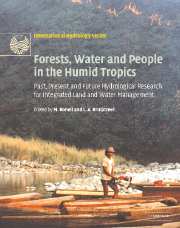 Forests, Water and People in the Humid Tropics
Forests, Water and People in the Humid Tropics Book contents
- Frontmatter
- Contents
- List of contributors
- Foreword
- Preface
- Acknowledgements
- Symposium and Workshop
- Introduction
- Part I Current trends and perspectives on people–land use–water issues
- 1 Trends and patterns of tropical land use change
- 2 The myth of efficiency through market economics: a biophysical analysis of tropical economies, especially with respect to energy, forests and water
- 3 Impacts of land cover change in the Brazilian Amazon: a resource manager's perspective
- 4 Forest people and changing tropical forestland use in tropical Asia
- 5 People in tropical forests: problem or solution?
- 6 Useful myths and intractable truths: the politics of the link between forests and water in Central America
- 7 Land use, hydrological function and economic valuation
- 8 Water resources management policy responses to land cover change in South East Asian river basins
- 9 Community-based hydrological and water quality assessments in Mindanao, Philippines
- Part II Hydrological processes in undisturbed forests
- Part III Forest disturbance, conversion and recovery
- Part IV New methods for evaluating effects of land-use change
- Part V Critical appraisals of best management practices
- Conclusion: Forests, water and people in the humid tropics: an emerging view
- Plate section
- References
3 - Impacts of land cover change in the Brazilian Amazon: a resource manager's perspective
from Part I - Current trends and perspectives on people–land use–water issues
Published online by Cambridge University Press: 12 January 2010
- Frontmatter
- Contents
- List of contributors
- Foreword
- Preface
- Acknowledgements
- Symposium and Workshop
- Introduction
- Part I Current trends and perspectives on people–land use–water issues
- 1 Trends and patterns of tropical land use change
- 2 The myth of efficiency through market economics: a biophysical analysis of tropical economies, especially with respect to energy, forests and water
- 3 Impacts of land cover change in the Brazilian Amazon: a resource manager's perspective
- 4 Forest people and changing tropical forestland use in tropical Asia
- 5 People in tropical forests: problem or solution?
- 6 Useful myths and intractable truths: the politics of the link between forests and water in Central America
- 7 Land use, hydrological function and economic valuation
- 8 Water resources management policy responses to land cover change in South East Asian river basins
- 9 Community-based hydrological and water quality assessments in Mindanao, Philippines
- Part II Hydrological processes in undisturbed forests
- Part III Forest disturbance, conversion and recovery
- Part IV New methods for evaluating effects of land-use change
- Part V Critical appraisals of best management practices
- Conclusion: Forests, water and people in the humid tropics: an emerging view
- Plate section
- References
Summary
The Brazilian Amazon is conceived nowadays as a green ocean, containing one of the world's major river systems with a water course network of more than 6500 km and responsible for 20% of the world's river discharge to the oceans (Figure 3.1). The Amazon river system includes a large annually inundated floodplain, or varzea (Richey et al., 1990) which represents an important natural resource base for food and energy production to meet human needs.
The Amazon is presently home to about 20 million people, mainly distributed in large, medium and small size urban and rural developments along the roads and rivers and concentrated heavily in the eastern part of the region (Figure 3.2).
The area of the Brazilian Amazon extends for about 500 million ha (equivalent to about two-thirds the size of the continental United States of America) of which about 80% falls within the tropical forest zone. Deforestation is currently running at around 1.6 million ha per year and its distribution closely follows the road network as illustrated in Figure 3.3 (Alves, 1999).
Schneider et al. (2000), using data from the 1995–6 Agricultural Census, report on land use by rainfall zone in the Brazilian Amazon (Table 3.1). They observe that, of the area under agricultural use, pasture is the dominant system, representing nearly 80%.
The sheer size of the Amazon region gives it global importance but it is also important as one of the last great frontiers for ‘modern man’ where the natural vegetation is largely intact, representing a store of biodiversity and playing an important role in global processes such as climate, carbon and hydrological cycles.
- Type
- Chapter
- Information
- Forests, Water and People in the Humid TropicsPast, Present and Future Hydrological Research for Integrated Land and Water Management, pp. 59 - 65Publisher: Cambridge University PressPrint publication year: 2005
References
- 1
- Cited by


